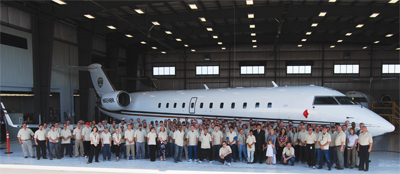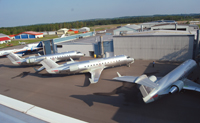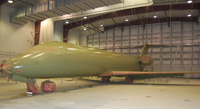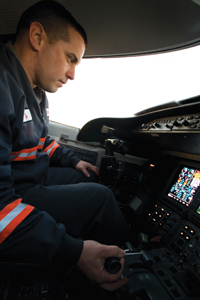
Features
MRO
A Symbiotic Relationship
There’s an old saying that if a job is worth doing, it’s worth doing well. For Peterborough, Ont.-based Flying Colours, quality is indeed an obsession – and cutting corners is not an option. Delivering top quality for money and creating happy clients is the number one priority.
November 4, 2010 By Rob Seaman
There’s an old saying that if a job is worth doing, it’s worth doing well. For Peterborough, Ont.-based Flying Colours, quality is indeed an obsession – and cutting corners is not an option. Delivering top quality for money and creating happy clients is the number one priority.
 |
|
| A commitment to quality and establishing an ironclad reputation in the industry are key elements anchoring the Flying Colours corporate philosophy – a perspective shared by every employee. PHOTOs: flying colours |
It’s a philosophy that’s obviously paying off in spades. After more than 20 years in the completions and overhaul business, Flying Colours has established itself as one of the top service providers in the world.
As the company’s fortunes have grown, so too have those of the place they call home – the Peterborough Municipal Airport (CYPQ). Owned by the City of Peterborough, the airfield currently boasts the longest paved, lighted runway between Ottawa and Toronto. It caters to, and welcomes, both business and general aviation and offers amenities beyond those of Flying Colours such as fuel, other aircraft repair and service providers, weather and even charter service.
The current 5,000-foot runway is equipped with new lighting and a PAPI (Precision Approach Path Indicator) approach system. Development of a GPS approach is also in the works. There is also a smaller 1,850 foot turf runway oriented northwest-southeast. The current terminal operations feature customs pre-clearance using CANPASS and a restaurant facility catering to local and transient traffic.
Aircraft movements at CYPQ currently number approximately 31,000 aircraft per year – a combination of recreational and commercial usage. The day-to-day activity includes many corporate jets, medical flights, flight school activity and cargo shipments. With no noise bylaws or operating hour curfews for freight and passenger flights, General Motors has become one of the main customers for its freight and cargo services.
Improvements in the works
On May 26, 2008, Peterborough city council adopted a number of recommendations regarding the airport development, including one that established a multi-year airport development program to run from 2008 to 2013. They directed staff to pursue all opportunities for Federal and Provincial Infrastructure Funding. On Oct. 16, 2009, it was announced that the city would undertake a $21 million Infrastructure Stimulus Fund (ISF) application to the Airport Major Infrastructure Project. This was approved, and the Federal and Provincial governments each agreed to contribute $7 million to match the city’s $7 million. Some additional elements since then have driven the combined projects to a total of $28.6 million, with the city’s share of the amount, $14.6 million.

|
|
| The expansion of Peterborough Municipal Airport – and specifically, lengthening the runway – will help Flying Colours take the next step in its development. PHOTOs: flying colours
|
On Aug. 26, 2010, a formal groundbreaking ceremony was held to celebrate the new airport development. The project, now well underway, entails the construction of a comprehensive aviation industrial park which will include an apron expansion (area designated for loading, unloading, refueling and maintaining aircraft), construction of a new central apron and air terminal building, groundside commercial development, and increasing the length of the runway from 5,000 to 7,000 ft. Actual construction work on the expansion and runway extension began in early August. The project is now full steam ahead, with the following work currently underway:
- Apron I – extension
- Apron II
- Runway extension east of Airport Rd.
- Taxiway extension
- Industrial lot preparation
- Runway extension to the west
- Installation of cul-de-sacs at Airport Rd. closure points
In September, a contractor was secured to begin construction on the new Air Terminal Building, which should be completed in the spring of 2011.
The new runway will allow Flying Colours to take the next step in its growth. “The airport expansion will help us to continue growing our business,” says Sean Gillespie, director, completion sales & management. “We were one of the reasons the City of Peterborough looked into expanding the airport. We do require a longer runway and improved infrastructure to expand into larger aircraft. The runway expansion will definitely help us. We have had requests for larger aircraft (above the Global/GV range) and this will allow us to further explore these requests. With that said, we do have our niche in the mid- to large-sized business jet market and are comfortable in it. We have been a big promoter of the potential of the airport for the city for a long time and it’s great to see it finally happening.”
Gillespie says Flying Colours is also planning a new facility in Peterborough following the completion of the airport expansion. The main goal of this building will be to accommodate additional “green” Bombardier completions. However, it will also be able to accommodate wide-body aircraft as that business comes along.
Exploring new frontiers
Growth is a term you hear often around Flying Colours. Even in what many call a stalled and slowly recovering market, Gillespie advises their perspective business is steady and there is evidence of recovery in certain markets. “We are actively growing our client base globally to maintain this steady pace, in particular in China, Russia, India, and the Middle East,” he says. “Our continued growth into green completions has helped expedite this.”
 |
|
| We work extremely hard to ensure we continue to positively enhance our reputation. PHOTOs: flying colours
|
Currently the business mix at Flying Colours is 60 per cent completions and 40 per cent refurbishments. Out of that, Gillespie estimates that the geographic business split is 35 per cent Asia (China, UAE, India, etc.); 25 per cent Russia/Kazakhstan/Ukraine; 25 per cent North America and 15 per cent from Europe.
Flying Colours has also been busy outside of the Peterborough operations. In 2009, the company acquired JetCorp Technical Services based in St.Louis, Mo. This addition has allowed them to continue their expansion and further establish themselves within the aircraft services industry. The new location operates as a Flying Colours company under the new name of JetCorp Technical Services Inc. With more than 25 years in business and an impeccable reputation for service and support in all areas, JetCorp was a welcome addition to the Flying Colours group of companies. By adding this company to their mix, Flying Colours has become a leading aviation service provider with concentration in the following areas:
- Green completions
- Refurbishment and modification
- Executive conversions
- Maintenance and repair
- Exterior paint
- Avionics upgrade and installation
- Engineering and design
- Component overhaul repair
- Auxiliary fuel systems
JetCorp recently moved into a larger facility on the same airport field (KSUS). As Gillespie sees it, as the St. Louis branch grows, it is evitable that additional growth will occur there. Looking beyond the shores of North America, he advises that they have researched additional expansion. “With the continued growth of business aviation outside North America, it would only be prudent to do so,” he says. “We have had initial discussions with groups in specific locations and will continue to monitor and evaluate these opportunities moving forward.”
One of the most successful projects currently underway at Flying Colours involves their “Green Challenger 850 Program. Gillespie says the initiative is progressing well. “We have completed four to date and have another four in progress between the two facilities. The positive reaction we have received on the quality of completion has led to discussions on other Bombardier green platforms with our clients,” he notes.
The green approach
Flying Colours is not insensitive to the environmental concerns that aviation can bring to light – especially with the chemicals involved in their various processes and the potential for waste from the aircraft refurbishing work. They have implemented – as much as possible – a “green working environment.” “There is a great deal of waste in our business,” says Gillespie. “For example, old removed interiors, old aircraft parts, and so forth. We try and re-use all this or donate it to local colleges as well as or our own program with SSFC (Sir Sanford Fleming College), called Aircraft Interior Fundamentals. A larger number of old seats, sidewalls and cabinets have gone to this program to be used as training tools.”
 |
|
| The business mix at Flying Colours is 60 per cent completions and 40 per cent refurbishments. PHOTOs: flying colours
|
In addition Flying Colours has, over the past 18 months, implemented a “Lean Workplace” – one of the principles being reducing waste within the workplace through greater efficiency and better processes. This has allowed them to reduce overall waste consumption. Lastly, they have replaced their crew and client vehicles with two hybrid units. Collectively, this demonstrates a recognition of, and commitment to, taking care of the environment, as well as making a positive contribution to the community. Aiding in the development of the next generation of potential aviation industry professionals is another important corporate objective.
A sound reputation
Flying Colours is steadfastly sticking to its fundamental corporate objectives – and it’s paying off. With no government funding to aid it, it has made its mark on the global stage. The majority of its success has come by reputation and word of mouth. And while they do advertise in some areas, Gillespie says reputation is what counts in the aviation services business. “We work extremely hard to ensure we continue to positively enhance our reputation regardless of the scope of the job,” he says. Sean says his father, John, started the business that way and he and his sister, Kate, and brother, Eric, continue to build and work within this philosophy today. By all accounts, it’s working.
| Numbers Game A snapshot of the Peterborough Municipal Airport expansion Mid October, 2009 – Airport project was approved under the Infrastructure Stimulus Fund. March 31, 2011 – Timeline for substantial completion. $140 million – Amount the federal and provincial governments will contribute to the project. 80 – Number of direct full-time employees the expansion is expected to generate. 7,000 – Number of feet runway will be lengthened, opening it to Boeing 737 and Airbus 320 class jets. $16.5 million – Indirect and direct increase in local annual gross domestic product due to expansion. |